Imagine this scenario:
You grab your purse and head to the nearest Michaels. You’ve run out of adhesive and can’t scrapbook another layout until you restock.
But when you arrive, you notice the end cap of new Heidi Swapp products. Then you remember how you’ve wanted to try art journaling.
You also recall that you still haven’t picked out an album for that personal history project you (finally) want to begin.
Before you know it, your basket is heavy and you’re fired up to get creating. Fortunately you have some coupons that take the sting out of what was supposed to be a $6 purchase.
And when you get home, what’s the first thing you use? The adhesive.
Does this sound familiar?
It sure does to me. Even though I recognize that stores employ psychologists so that I will spend more, I do it anyway.
It happens online too. Even been to Amazon.com? Their magic algorithms love to recommend items they know you “want”—and it totally works.
Fortunately you can outsmart your primitive urges so that every purchase makes sense and feels right.

It’s not necessarily about buying less though, but about aligning your spending with your creating. Here’s how to start:
1. Let go of past regrets and guilt about spending. The money you’ve released is gone. It’s OK. Every day presents a new opportunity to make a smarter spending decision.
To move forward, you must give yourself permission to let go of this regret and guilt. Shame about these past choices can get in they way of your best creative motivation, leaving you stuck and frustrated.
2. Identify what really works best for your hobby. You’ll often hear to buy what you love and will use, but it can feel difficult to identify those items. You can back into this revelation by looking first for what you don’t use.
Look for past purchases that have gone untouched or under-utilized. Then instead of looking at these items as markers of poor choices, you can embrace them as valuable pieces of information about what actually works best for you.
3. Develop a stronger sense of your priorities. Less-than-smart spending is often on items that don’t have a clear purpose or function in your hobby. To avoid purchasing “just because”, you can make more informed decisions by knowing what you’ll be working on.
You don’t need to be super specific, but instead identify which formats currently fill you up and fit your lifestyle. How will your time be divided between traditional layouts, digital pages, full album projects, pocket pages, or mini books?
If there’s a format you’re not using, then why are you still buying more supplies for it?
4. Create a supply list for the upcoming season. When you have a sense of how you’re telling stories these days, you can use that information to make more intentional spending choices. This begins with a general list of supplies that might work well for you.
For example, if you’re consistently working only on pocket pages, you might find a kit subscription helpful. However, if those 3×4 cards are just piling up because you only make layouts, your purchases may need to focus on white cardstock and adhesive.
5. Start a small slush fund for impulse purchases. Intentional spending doesn’t mean never picking up a great deal or grabbing something just because it excites you. It’s OK to buy because you want it and it feels good.
However, when the majority of your decisions are guided by needs, you can spend a little on your wants without regret. The best way to handle this is with a small reserve (like an envelope in your purse) that’s just for extras.
Did you notice how I didn’t recommend setting a budget? When you have a clear idea of what your hobby looks like when it’s purposeful, staying within your means won’t be a big deal. In fact, you’ll probably even have money left over!


Late last month I realized that I’m not overly fond of “Mega Flake”, a foil product in various mixes of colors. I used it to make one birthday card. It required that I put a glue on a stamp, stamp the glue off onto a blank card and then sprinkle the foil pieces all over the card. Made sure the loose pieces were sticking to the glue and then used the “scrunchy” , a wide mesh of thin plastic, to rub the extra off. I’ll admit it looked nice when I was done but……
That foil flies all OVER THE PLACE. I was wearing it, not only on my clothes but also on my skin. My craft mat STILL has little pieces of colorful foil bits.
So I won’t be using that product again. I may be a clutter bug but I don’t appreciate gluey messes.
Now I have to decide whether I’m going to give the jars (I have at least 6 jars, all different mixes) to our local thrift store or somehow advertise locally or just throw them out (empty them into the trash and then reuse the jars.)